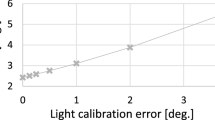Abstract
Recently, various techniques of shape reconstruction using cast shadows have been proposed. These techniques have the advantage that they can be applied to various scenes, including outdoor scenes, without using special devices. Previously proposed techniques usually require calibration of camera parameters and light source positions, and such calibration processes limit the range of application of these techniques. In this paper, we propose a method to reconstruct 3D scenes even when the camera parameters or light source positions are unknown. The technique first recovers the shape with 4-DOF indeterminacy using coplanarities obtained by cast shadows of straight edges or visible planes in a scene, and then upgrades the shape using metric constraints obtained from the geometrical constraints in the scene. In order to circumvent the need for calibrations and special devices, we propose both linear and nonlinear methods in this paper. Experiments using simulated and real images verified the effectiveness of this technique.
Similar content being viewed by others
References
Bartoli, A., & Sturm, P. (2003). Constrained structure and motion from multiple uncalibrated views of a piecewise planar scene. International Journal of Computer Vision, 52(1), 45–64.
Bouguet, J. Y., & Perona, P. (1998). 3D Photography on your desk. In International conference on computer vision (pp. 129–149).
Bouguet, J.-Y., Weber, M., & Perona, P. (1999). What do planar shadows tell about scene geometry? In CVPR (Vol. 01, pp. 514–520).
Caspi, Y., & Werman, M. (2006). Vertical parallax from moving shadows. In CVPR (pp. 2309–2315), Washington, DC, USA. Los Alamitos: IEEE Comput. Soc.
Criminisi, A., Reid, I. D., & Zisserman, A. (2000). Single view metrology. International Journal of Computer Vision, 40(2), 123–148.
Daum, M., & Dudek, G. (1998). On 3-D surface reconstruction using shape from shadows. In CVPR (pp. 461–468).
Hambrick, L. N., Loew, M. H., & Carroll, J. R. L. (1987). The entry exit method of shadow boundary segmentation. IEEE Transactions on Pattern Analysis and Machine Intelligence, 9(5), 597–607.
Hatzitheodorou, M., & Kender, J. (1988). An optimal algorithm for the derivation of shape from shadows. In CVPR (pp. 486–491).
Jiang, C., & Ward, M. O. (1994). Shadow segmentation and classification in a constrained environment. Computer Vision, Graphics, and Image Processing, Image Understanding, 59(2), 213–225.
Kawasaki, H., & Furukawa, R. (2007). Dense 3D reconstruction method using coplanarities and metric constraints for line laser scanning. In International conference on 3D digital imaging and modeling.
Kriegman, D. J., & Belhumeur, P. N. (2001). What shadows reveal about object structure. Journal of the Optical Society of America, 18(8), 1804–1813.
Raviv, D., Pao, Y., & Loparo, K. A. (1989). Reconstruction of three-dimensional surfaces from two-dimensional binary images. IEEE Transactions on Robotics and Automation, 5(5), 701–710.
Salvador, E., Cavallaro, A., & Ebrahimi, T. (2004). Cast shadow segmentation using invariant color features. Computer Vision and Image Understanding, 95(2), 238–259.
Sato, K., & Inokuchi, S. (1987). Range-imaging system utilizing nematic liquid crystal mask. In Proc. of first international conference on computer vision (pp. 657–661).
Savarese, S., Andreetto, M., Rushmeier, H., Bernardini, F., & Perona, P. (2007). 3D reconstruction by shadow carving: theory and practical evaluation. International Journal of Computer Vision, 71(3), 305–336.
Shafer, S. A., & Kanade, T. (1983). Using shadows in finding surface orientations. Computer Vision, Graphics, and Image Processing, 22(1), 145–176.
Sugihara, K. (1986). Machine interpretation of line drawings. Cambridge: MIT Press.
Yamazaki, S., Narasimhan, S. G., Baker, S., & Kanade, T. (2007). Coplanar shadowgrams for acquiring visual hulls of intricate objects. In International conference on computer vision.
Yu, Y., & Chang, J. T. (2005). Shadow graphs and 3D texture reconstruction. International Journal of Computer Vision, 62(1-2), 35–60.
Author information
Authors and Affiliations
Corresponding author
Rights and permissions
About this article
Cite this article
Kawasaki, H., Furukawa, R. Shape Reconstruction and Camera Self-Calibration Using Cast Shadows and Scene Geometries. Int J Comput Vis 83, 135–148 (2009). https://doi.org/10.1007/s11263-008-0188-7
Received:
Accepted:
Published:
Issue Date:
DOI: https://doi.org/10.1007/s11263-008-0188-7




